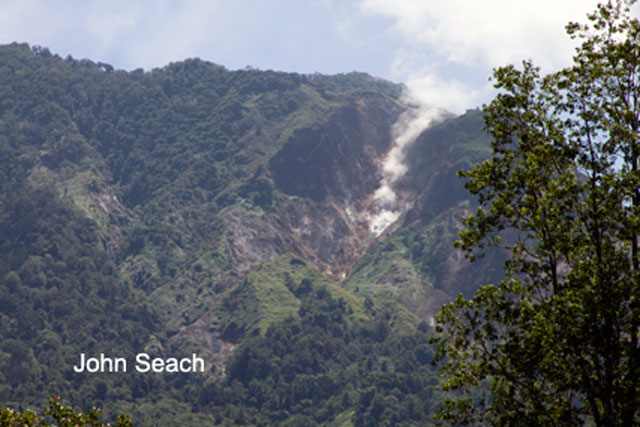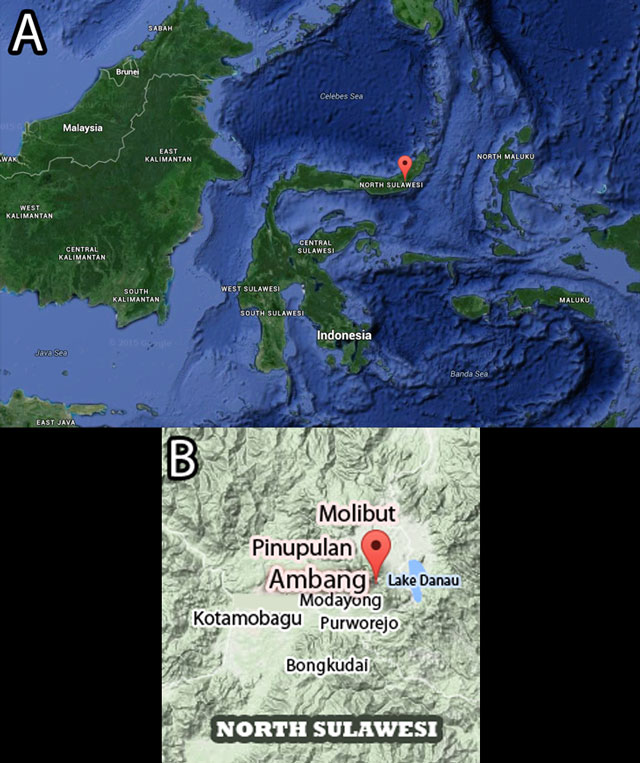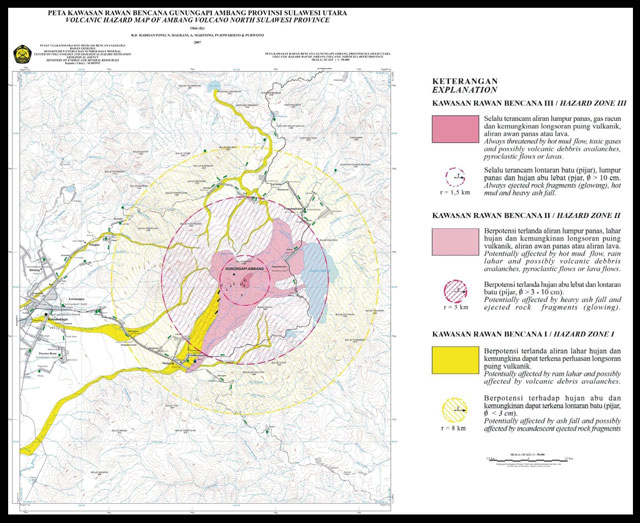Report on Ambang (Indonesia) — September 2014
Bulletin of the Global Volcanism Network, vol. 39, no. 9 (September 2014)
Managing Editor: Richard Wunderman.
Ambang (Indonesia) 1966 to August 2014; sporadic eruptions and seismicity
Please cite this report as:
Global Volcanism Program, 2014. Report on Ambang (Indonesia) (Wunderman, R., ed.). Bulletin of the Global Volcanism Network, 39:9. Smithsonian Institution. https://doi.org/10.5479/si.GVP.BGVN201409-266020
Ambang
Indonesia
0.75°N, 124.42°E; summit elev. 1795 m
All times are local (unless otherwise noted)
This Bulletin report, our first one on Ambang (figure 1), covers activity from 1966 to August 2014. Activity was sporadic, with decades of neither eruptions nor significant seismicity. Data for this report was gathered primarily from the Pusat Vulkanologi dan Mitigasi Bencana Geologi (PVMBG; here referenced as CVGHM which stands for Center for Volcanology and Geological Hazard Mitigation) and the Darwin Volcanic Ash Advisory Centre (VAAC).
1966 to 2013. In 1966, earthquakes were felt as far away as Purworejo (figure 1). These were followed closely by the release of sulfurous gases through two new vents near Kali Putih E and on the N slopes of Ambang's crater.
On 22 December 2005, Ambang erupted phreatically, forming a fumarolic field that was still in existence during 2014.
According to CVGHM (2014), resulting pyroclastic flows from potential magmatic eruptions were most likely at that time to affect villages to the SE, including settlements such as Bongkudai, Goaan, Purworejo, and Modayong.
Ambang's seismic activity for this reporting interval was generally mild and the hazard status mostly remained low (Level I). In 2010, seismicity substantially increased with a maximum of 33 earthquakes (during unstated interval) and the Alert Level was raised to II (on a scale of I-IV).
In June 2013, there were two active fumaroles on the SW side of Ambang, based on an expedition by John Seach that was reported on VolcanoLive. The westernmost fumarole emitted a thin white plume to ~100 m above the vent and the easternmost fumarole occasionally emitted short white vapor (figure 2). Furthermore, the team noted that the summit was "heavily forested" and there was "a strong smell of sulfur."
 |
Figure 2. A fumarole on Ambang released a plume to several meters high. More pictures of Seach's visit are listed on the VolcanoLive website. Photograph by John Seach. Courtesy of VolcanoLive. |
Activity during 2014. From June to August 2014, Ambang had a short-lived substantial increase in volcanic seismicity and a more constant tectonic seismicity (table 1). On 3 July 2014, CVGHM raised the alert level from Normal (I) to Alert (II), and the region within 1.5 km of the crater was cordoned off. Thin, gas emissions were observed rising throughout June, July, and August from the crater to a height of 10-25 m. By 8 August, the volcanic seismicity decreased and CVGHM lowered the alert level from II to I. The Aviation Color Code also changed from Yellow to Green, based on a Darwin VAAC report. However, residents were still cautioned not to approach the crater.
Table 1. Number of earthquakes between June and August 2014 as recorded by analog and digital CVGHM seismographs at Ambang. (Exact location of seismographs unspecified.) Volcanic (Volc.) earthquakes are categorized based on their depths as shallow or deep; and the tectonic (tect.) earthquakes, based on their distances from Ambang as local or distant. Note that CVGHM did not quantify "shallow," "deep," "local," and "distant." The time intervals are of irregular length. Data courtesy of CVGHM.
| Date | Shallow (volc) | Deep (volc.) | Local (tect.) | Distant (tect.) |
| 01 Jun-08 Jun 2014 | 8 | 7 | 1 | 31 |
| 09 Jun-16 Jun 2014 | 7 | 2 | 1 | 34 |
| 17 Jun-24 Jun 2014 | 8 | 9 | 1 | 35 |
| 25 Jun-02 Jul 2014 | 9 | 6 | 0 | 29 |
| 03 Jul 2014 | 33 | 29 | 0 | 0 |
| 01 Jul-10 Jul 2014 | 58 | 45 | 2 | 41 |
| 11 Jul-19 Jul 2014 | 92 | 30 | 1 | 38 |
| 20 Jul-28 Jul 2014 | 123 | 39 | 1 | 38 |
| 29 Jul-06 Aug 2014 | 28 | 9 | 0 | 43 |
CVGHM background. The Ambang stratovolcano consists of a row of relatively-young cones from the Quaternary period, which extend N and S. It lies in an area cut by normal faults. Ambang's generally has had repose intervals of 39 to 127 years between eruptions.
CVGHM also noted that previous eruptions were often dominated by lava flows, pyroclastic flows, and ashfall.
As seen on figure 3, the regions affected by eruptions at Ambang have been qualified by Hadisantono and others (2007) into hazard zones I (yellow), II (light pink), and III (darker pink). Each of these areas is defined by both a radial area with circles, as well as specific irregularly shaped zones corresponding to topography or local conditions. The key is in both Indonesian and English (legible on the pdf version).
According to CVGHM (2014), the population densities for hazard zones I and II have increased dramatically in the past decades. They noted 17,240 people in hazard zone II alone as of 2014.
Geochemistry tables for Ambang appear in CVGHM (2014) and in Jaffe and others (2004).
References. Hadisantono, R.D.; Haerani, N.; Martono, A.; Pujowarsito; Purwoto; 2007; Peta Kawasan Rawan Bencana Gunungapi Ambang Provinsi Sulawesi Utari; Pusat Vulkanologi Dan Mitigase Bencana Geologi Departemen Energi Dan Sumber Daya Mineral, Featured in CVGHM (2014) (URL: http://www.vsi.esdm.go.id/index.php/gunungapi/data-dasar-gunungapi/481-g-ambang?start=6) [accessed in March 2015]
Jaffe, L. A.; Hilton, D. R.; Fischer, T. P.; Hartono, U; 2004; Tracing magma sources in an arc-arc collision zone: Helium and carbon isotope and relative abundance systematics of the Sangihe Arc, Indonesia. (URL: http://onlinelibrary.wiley.com/doi/10.1029/2003GC000660/abstract)
CVGHM [Pusat Vulkanologi dan Mitigasi Bencana Geologi]; (28 May) 2014; 6.2 G. Ambang Sulawesi Utari; [Published as pdf in Indonesian, with occasional English and containing the Hadisantono and others (2007) hazard map], 10 pages (URL: http://www.vsi.esdm.go.id/index.php/gunungapi/data-dasar-gunungapi/481-g-ambang) [accessed in March 2015]
VolcanoLive; 2014; Ambang Volcano – John Seach (URL: http://www.volcanolive.com/ambang.html) [accessed March 2015]
Geological Summary. The compound Ambang volcano is the westernmost of the active volcanoes on the northern arm of Sulawesi. The stratovolcano rises 750 m above lake Danau. Several craters up to 400 m in diameter and five solfatara fields are located at the summit.
Information Contacts: Center for Volcanology and Geological Hazard Mitigation (CVGHM, Pusat Vulkanologi dan Mitigasi Bencana Geologi), Badan Geologi, Kementerian Energi dan Sumber Daya Mineral (ESDM), Yogyakarta 55166, Indonesia (URL: http://www.vsi.esdm.go.id/); Darwin Volcanic Ash Advisory Centre (VAAC) (URL: http://www.bom.gov.au/info/vaac/).



